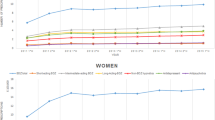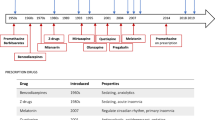Abstract
Purpose
Chronic use of sedative-hypnotics is very common, although not guideline-endorsed. The incidence among new users is not well studied, and there are currently no recommendations favoring any specific agent. We quantified the risk for chronic use in first-time hypnotic users, and the association of the initial choice of hypnotic with later usage patterns.
Methods
We used the computerized database of Israel’s largest healthcare provider. All 236,597 new users of sedative-hypnotics between the years 2000–2005 were followed for 10 years. Filled prescriptions in the second, fifth, and tenth years were recorded. The association of the first hypnotic choice (benzodiazepine/Z-drug) with chronic consumption was assessed using multivariate logistic regression.
Results
Average age on first use was 63.7 (SD ± 16.4) years. 58.6% were women. Benzodiazepines were initiated in 154,929 (65.5%) of the cases. Benzodiazepine users were older and of lower socioeconomic status, compared to Z-drug users (p < 0.001). On the tenth year, 103,912 (66.8%) of new users claimed ≤ 30 DDDs of hypnotics, 3,1724 (20.4%) were long-term users (≥ 180 DDD/year), and 828 (0.5%) used excessively (≥ 720 DDD/year). Z-drugs were associated with an increased risk of long-term use on the second year [17.3% vs. 12.4%, RR = 1.40 (1.37–1.43)] as well as on the fifth [21.9% vs. 13.9%, RR = 1.58 (1.55–1.61)] and tenth year [25.1% vs. 17.7%, RR = 1.42 (1.39–1.45)], p < 0.0001. Similar results were also observed for daily and excessive use (p < 0.001).
Conclusions
One in five new users of sedative-hypnotics will become a long-term user, but only 0.5% will become excessive users. Z-drugs were associated with an increased risk of chronic use.

Similar content being viewed by others
References
Solomon CG, Winkelman JW (2015) Insomnia disorder. N Engl J Med 373:1437–1444. https://doi.org/10.1056/NEJMcp1412740
Riemann D, Baglioni C, Bassetti C, Bjorvatn B, Dolenc Groselj L, Ellis JG, Espie CA, Garcia-Borreguero D, Gjerstad M, Gonçalves M, Hertenstein E, Jansson-Fröjmark M, Jennum PJ, Leger D, Nissen C, Parrino L, Paunio T, Pevernagie D, Verbraecken J, Weeß HG, Wichniak A, Zavalko I, Arnardottir ES, Deleanu OC, Strazisar B, Zoetmulder M, Spiegelhalder K (2017) European guideline for the diagnosis and treatment of insomnia. J Sleep Res 26:675–700. https://doi.org/10.1111/jsr.12594
Qaseem A, Kansagara D, Forciea MA, Cooke M, Denberg TD, for the Clinical Guidelines Committee of the American College of Physicians (2016) Management of chronic insomnia disorder in adults: a clinical practice guideline from the American college of physicians. Ann Intern Med 165:125–133. https://doi.org/10.7326/M15-2175
Schmitz MF (2016) The ACP guidelines for treatment of chronic insomnia: the challenge of implementation. Behav Sleep Med 14:699–700. https://doi.org/10.1080/15402002.2016.1220131
Sateia MJ, Buysse DJ, Krystal AD, Neubauer DN, Heald JL (2017) Clinical practice guideline for the pharmacologic treatment of chronic insomnia in adults: an American Academy of Sleep Medicine Clinical Practice Guideline. J Clin Sleep Med J Clin Sleep Med J Clin Sleep Med 1313:307–349. https://doi.org/10.5664/jcsm.6470
Bertisch SM, Herzig SJ, Winkelman JW, Buettner C (2014) National use of prescription medications for insomnia: NHANES 1999-2010. Sleep 37:343–349. https://doi.org/10.5665/sleep.3410
Kripke DF (2016) Hypnotic drug risks of mortality, infection, depression, and cancer: but lack of benefit. F1000Research 5:918. doi: https://doi.org/10.12688/f1000research.8729.1
Kurko TAT, Saastamoinen LK, Tähkäpää S, Tuulio-Henriksson A, Taiminen T, Tiihonen J, Airaksinen MS, Hietala J (2015) Long-term use of benzodiazepines: definitions, prevalence and usage patterns – a systematic review of register-based studies. Eur Psychiatry 30:1037–1047. https://doi.org/10.1016/j.eurpsy.2015.09.003
Anthierens S, Pasteels I, Habraken H et al (2010) Barriers to nonpharmacologic treatments for stress, anxiety, and insomnia: family physicians’ attitudes toward benzodiazepine prescribing. Can Fam physician Médecin Fam Can 56:e398–e406
Sirdifield C, Anthierens S, Creupelandt H, Chipchase SY, Christiaens T, Siriwardena AN (2013) General practitioners’ experiences and perceptions of benzodiazepine prescribing: systematic review and meta-synthesis. BMC Fam Pract 14:191. https://doi.org/10.1186/1471-2296-14-191
Everitt H, Mcdermott L, Leydon G et al (2014) GPs’ management strategies for patients with insomnia : 112–119. https://doi.org/10.3399/bjgp14X677176.Conclusion
Campanelli CM (2013) American Geriatrics Society Updated Beers Criteria for potentially inappropriate medication use in older adults: the American Geriatrics Society 2012 Beers Criteria Update Expert Panel. J Am Geriatr Soc 60:616–631
Oecd (2015) Health at a glance 2015. OECD Publishing
Matalon A, Yinnon AM, Hurwitz A (1990) Chronic use of hypnotics in a family practice--patients’ reluctance to stop treatment. Fam Pract 7:258–260
Mah L, Upshur REG (2002) Long term benzodiazepine use for insomnia in patients over the age of 60: discordance of patient and physician perceptions. BMC Fam Pract 3:9
van Hulten R, Teeuw B, Bakker A, Leufkens HG (2005) Initial benzodiazepine use and improved health-related quality of life. Pharm World Sci 27:41–46
Soyka M (2017) Treatment of benzodiazepine dependence. N Engl J Med 376:1147–1157. https://doi.org/10.1056/NEJMra1611832
Huedo-Medina TB, Kirsch I, Middlemass J, Klonizakis M, Siriwardena AN (2012) Effectiveness of non-benzodiazepine hypnotics in treatment of adult insomnia: meta-analysis of data submitted to the Food and Drug Administration. BMJ 345:e8343. https://doi.org/10.1136/bmj.e8343
Krystal AD, Walsh JK, Laska E, Caron J, Amato DA, Wessel TC, Roth T (2003) Sustained efficacy of eszopiclone over 6 months of nightly treatment: results of a randomized, double-blind, placebo-controlled study in adults with chronic insomnia. Sleep 26:793–799
Roehrs TA, Randall S, Harris E et al (2011) Twelve months of nightly zolpidem does not lead to dose escalation: a prospective placebo-controlled study. Sleep 34:207–212
Ancoli-Israel S, Richardson GS, Mangano RM, Jenkins L, Hall P, Jones WS (2005) Long-term use of sedative hypnotics in older patients with insomnia. Sleep Med 6:107–113. https://doi.org/10.1016/j.sleep.2004.10.015
Roth T, Walsh JK, Krystal A et al (2005) An evaluation of the efficacy and safety of eszopiclone over 12 months in patients with chronic primary insomnia. Sleep Med 6:487–495. https://doi.org/10.1016/j.sleep.2005.06.004
Randall S, Roehrs TA, Roth T (2012) Efficacy of eight months of nightly zolpidem: a prospective placebo-controlled study. Sleep 35:1551–1557. https://doi.org/10.5665/sleep.2208
Krystal AD, Erman M, Zammit GK, Soubrane C, Roth T, ZOLONG Study Group (2008) Long-term efficacy and safety of zolpidem extended-release 12.5 mg, administered 3 to 7 nights per week for 24 weeks, in patients with chronic primary insomnia: a 6-month, randomized, double-blind, placebo-controlled, parallel-group, multicenter study. Sleep 31:79–90
Mattila T, Stoyanova V, Elferink A, Gispen-de Wied C, de Boer A, Wohlfarth T (2011) Insomnia medication: do published studies reflect the complete picture of efficacy and safety? Eur Neuropsychopharmacol 21:500–507. https://doi.org/10.1016/j.euroneuro.2010.10.005
Wilson S, Nutt D, Alford C, Argyropoulos SV, Baldwin DS, Bateson AN, Britton TC, Crowe C, Dijk DJ, Espie CA, Gringras P, Hajak G, Idzikowski C, Krystal AD, Nash JR, Selsick H, Sharpley AL, Wade AG (2010) British Association for Psychopharmacology consensus statement on evidence-based treatment of insomnia, parasomnias and circadian rhythm disorders. J Psychopharmacol 24:1577–1601. https://doi.org/10.1177/0269881110379307
Matheson E, Hainer BL (2017) Insomnia: pharmacologic therapy. Am Fam Physician 96:29–35
Creado S, Plante DT (2016) An update on the use of sedative-hypnotic medications in psychiatric disorders. Curr Psychiatry Rep 18:78. https://doi.org/10.1007/s11920-016-0717-y
Ford ES, Wheaton AG, Cunningham TJ, Giles WH, Chapman DP, Croft JB (2014) Trends in outpatient visits for insomnia, sleep apnea, and prescriptions for sleep medications among US adults: findings from the National Ambulatory Medical Care Survey 1999-2010. Sleep 37:1283–1293. https://doi.org/10.5665/sleep.3914
Wilt TJ, MacDonald R, Brasure M, Olson CM, Carlyle M, Fuchs E, Khawaja IS, Diem S, Koffel E, Ouellette J, Butler M, Kane RL (2016) Pharmacologic treatment of insomnia disorder: an evidence report for a clinical practice guideline by the American college of physicians. Ann Intern Med 165:103–112. https://doi.org/10.7326/M15-1781
OECD (2012) OECD reviews of health care quality: Israel 2012. OECD Publishing
The Israel Drug Registry. http://www.old.health.gov.il/units/pharmacy/trufot/index.asp?safa=e. Accessed 13 Apr 2016
Ray WA (2003) Evaluating medication effects outside of clinical trials: new-user designs. Am J Epidemiol 158:915–920. https://doi.org/10.1093/aje/kwg231
WHO Collaborating Centre for Drug Statistics Methodology (2016) Guidelines for ATC classification and DDD assignment 2016. Oslo. . Oslo
Zandstra SM, Furer JW, van de Lisdonk EH, van’t Hof M, Bor JHJ, van Weel C, Zitman FG (2002) Different study criteria affect the prevalence of benzodiazepine use. Soc Psychiatry Psychiatr Epidemiol 37:139–144. https://doi.org/10.1007/s001270200006
Manor O (2015) Program for quality indicators in community healthcare in Israel Report 2013-2014
Cloos J-M, Bocquet V, Rolland-Portal I, Koch P, Chouinard G (2015) Hypnotics and triazolobenzodiazepines – best predictors of high-dose benzodiazepine use: results from the Luxembourg National Health Insurance Registry. Psychother Psychosom 84:273–283. https://doi.org/10.1159/000434755
Tvete IF, Bjørner T, Aursnes IA, Skomedal T (2013) A 3-year survey quantifying the risk of dose escalation of benzodiazepines and congeners to identify risk factors to aid doctors to more rationale prescribing. BMJ Open 3:e003296. https://doi.org/10.1136/bmjopen-2013-003296
Greenland S, Daniel R, Pearce N (2016) Outcome modelling strategies in epidemiology: traditional methods and basic alternatives. Int J Epidemiol 45:565–575. https://doi.org/10.1093/ije/dyw040
McNutt LA, Wu C, Xue X, Hafner JP (2003) Estimating the relative risk in cohort studies and clinical trials of common outcomes. Am J Epidemiol 157:940–943. https://doi.org/10.1093/aje/kwg074
Norton EC, Miller MM, Kleinman LC (2013) Computing adjusted risk ratios and risk differences in Stata. Stata J 13:492–509
Cohen R, Rabin H (2015) Membership in sick funds 2014 [Hebrew]. Jerusalem
Takeshima N, Ogawa Y, Hayasaka Y, Furukawa TA (2016) Continuation and discontinuation of benzodiazepine prescriptions: a cohort study based on a large claims database in Japan. Psychiatry Res 237:201–207. https://doi.org/10.1016/j.psychres.2016.01.040
Willems IAT, Gorgels WJMJ, Oude Voshaar RC, Mulder J, Lucassen PLBJ (2013) Tolerance to benzodiazepines among long-term users in primary care. Fam Pract 30:404–410. https://doi.org/10.1093/fampra/cmt010
Soumerai SB, Simoni-Wastila L, Singer C, Mah C, Gao X, Salzman C, Ross-Degnan D (2003) Lack of relationship between long-term use of benzodiazepines and escalation to high dosages. Psychiatr Serv 54:1006–1011. https://doi.org/10.1176/appi.ps.54.7.1006
Gray SL, Eggen AE, Blough D et al (2003) Benzodiazepine use in older adults enrolled in a health maintenance organization. Am J Geriatr Psychiatry 11:568–576. https://doi.org/10.1176/appi.ajgp.11.5.568
Mandrioli R, Mercolini L, Raggi M (2008) Benzodiazepine metabolism: an analytical perspective. Curr Drug Metab 9:827–844. https://doi.org/10.2174/138920008786049258
Schutte-Rodin S, Broch L, Buysse D, Dorsey C, Sateia M (2008) Clinical guideline for the evaluation and management of chronic insomnia in adults. J Clin Sleep Med 4:487–504
Salzman C (1991) The APA Task Force report on benzodiazepine dependence, toxicity, and abuse. Am J Psychiatry 148:151–152. https://doi.org/10.1176/ajp.148.2.151
de las Cuevas C, Sanz E, de la Fuente J (2003) Benzodiazepines: more “behavioural” addiction than dependence. Psychopharmacology 167:297–303. https://doi.org/10.1007/s00213-002-1376-8
Kjosavik SR, Ruths S, Hunskaar S (2012) Use of addictive anxiolytics and hypnotics in a national cohort of incident users in Norway. Eur J Clin Pharmacol 68:311–319. https://doi.org/10.1007/s00228-011-1124-2
Yen CF, Ko CH, Chang YP, Yu CY, Huang MF, Yeh YC, Lin JJ, Chen CS (2015) Dependence, misuse, and beliefs regarding use of hypnotics by elderly psychiatric patients taking zolpidem, estazolam, or flunitrazepam. Asia Pac Psychiatry 7:298–305. https://doi.org/10.1111/appy.12147
Fang SY, Chen CY, Chang IS, Wu ECH, Chang CM, Lin KM (2009) Predictors of the incidence and discontinuation of long-term use of benzodiazepines: a population-based study. Drug Alcohol Depend 104:140–146. https://doi.org/10.1016/j.drugalcdep.2009.04.017
Ayalon L, Gross R, Yaari A, Feldhamer E, Balicer RD, Goldfracht M (2013) Patients’ and physicians’ characteristics associated with the purchase of benzodiazepines by older primary care patients in Israel. Admin Pol Ment Health 40:117–123. https://doi.org/10.1007/s10488-011-0381-9
Taipale H, Koponen M, Tanskanen A et al (2015) Long-term use of benzodiazepines and related drugs among community-dwelling individuals with and without Alzheimer’s disease. Int Clin Psychopharmacol 30:202–208. https://doi.org/10.1097/YIC.0000000000000080
Haukka J, Suvisaari J, Tuulio-Henriksson A, Lönnqvist J (2007) High concordance between self-reported medication and official prescription database information. Eur J Clin Pharmacol 63:1069–1074. https://doi.org/10.1007/s00228-007-0349-6
Lacasse A, Ware MA, Bourgault P et al (2015) Accuracy of self-reported prescribed analgesic medication use. Clin J Pain 32:1–102. https://doi.org/10.1097/AJP.0000000000000248
Author information
Authors and Affiliations
Corresponding author
Ethics declarations
Ethical approval was obtained from the CHS institutional ethics review board.
Electronic supplementary material
ESM 1
(DOCX 82 kb)
Rights and permissions
About this article
Cite this article
Schonmann, Y., Goren, O., Bareket, R. et al. Chronic hypnotic use at 10 years—does the brand matter?. Eur J Clin Pharmacol 74, 1623–1631 (2018). https://doi.org/10.1007/s00228-018-2531-4
Received:
Accepted:
Published:
Issue Date:
DOI: https://doi.org/10.1007/s00228-018-2531-4




